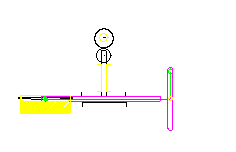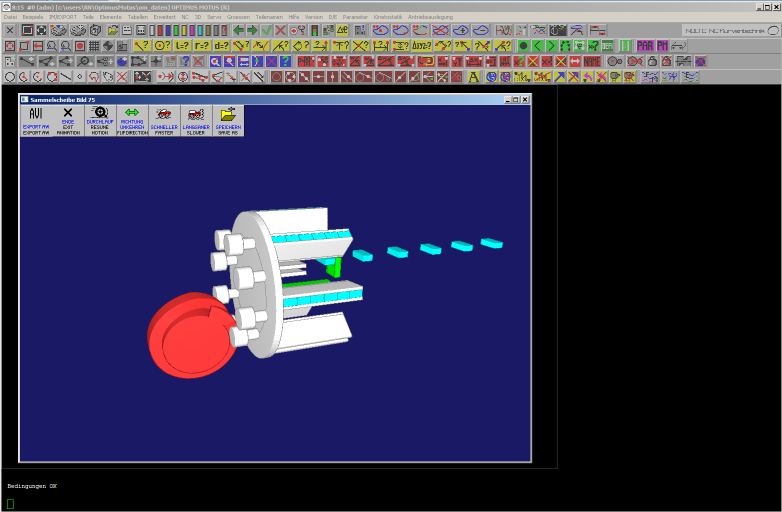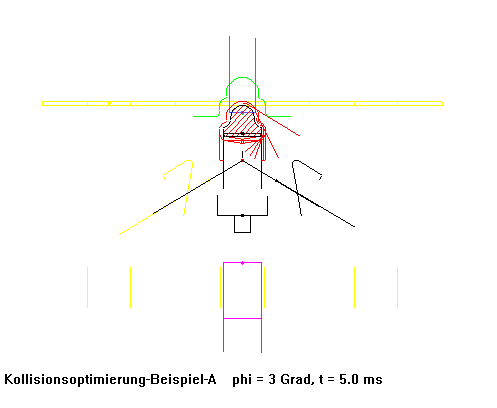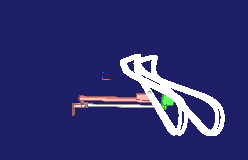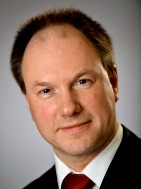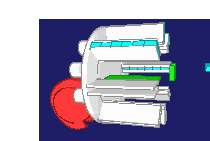Nolte-NC-Kurventechnik GmbH: Software and Services for Cam Design, Indexing Cams, Mechanisms and Motion Design
We are specialized in the calculation, evaluation and optimization of cams and indexing cam gears, the simulation and dynamic optimization of multiple concurrent motions controlled by cams, servo drives and linkages ("collision optimization"), the dynamic optimization of motions (motion design) and the synthesis of mechanisms.
For that, we offer powerful cam and mechanism design software and consulting (calculation service, trainings etc.).
We reduce accelerations, torques, forces and vibration in machines, especially with our know how in motion design, cam design and our vast database of motion laws.
We estimate the durability of cams and rollers and make suggestions for servo motors and gears, based on dynamic calculations.
We improve performance, speed and durability of machines.
In short: We make machines faster, quieter, more powerful and more efficient. This saves money, your money.
Go to ...
- Our approach
- Products
- References
- History
- Flyer Nolte NC-Kurventechnik
- Contact
- Homepage Nolte NC-Kurventechnik
- Software for Cam Design, Linkages and Servo Drive Optimization
- Cam Calculation
- Service
- Mechanisms
- Cam Design
- Indexing mechanisms
- Training
- Electronic Cams, Servo+PLC
- Motion design
- Motion laws
- Legal notices, Privacy policy, Publisher’s imprint, Disclaimer
Our approach
Most machines are taylored for the needs of your customers and for given product formats.
Delivery times are very short and fixed, but your customers reveals important parameters very late.
Customers request high machine performance, machines must be faster than their predecessors, and they want high stability in the machine's processes.
The cycle speed was fixed between sales and customer, before the machine was engineered.
Do you know that? This is what many of our customers experience.
When writing quotations you need a safe statement about the reachable cycle speed. If you promise too much, the engineers will not be able to stick to your promises, and you will have disputes with your customer, workovers and expensive installer applications at the customer's site. On the other hand, if you are too cautious, your competitor will win the job with a more courageous quotation.
In engineering you profit from good and quickly done mechanism and motion design, cam calculation and servoprogramming. The first shot should be an almost perfect design and fully exploit the potential of your machine. You cannot make lengthy studies or build prototypes because it would cost too much, and because the delivery time is too short.
When mechanism layout, cam design and motion design are done and the machine is constructed, the production needs data for cutting the cams, and PLC programmers need data sets for programming the drives.
Our software OPTIMUS MOTUS and our consulting with calculations and simulations support you in all these project phases.
With our software:
Mechanisms can be modeled in OPTIMUS MOTUS with kinematics, loads and smooth motions with few mouse clicks. CAD models are not necessary for that. In a few minutes you estimate whether a product can be processed within a given cycle time or not, which drive torques you have to deal with and what roller and cam durabilities can be expected.
The software OPTIMUS MOTUS is best suited for feasibility studies in mechanism, cam and motion design.
Look here for ...
- Cam Design Software
- PLC Programming Software
- Mechanism Software (Kinematics and Dynamics)
- Indexer Software
If you already have a CAD model for your machine, you can transfer the geometry into OPTIMUS MOTUS and make a simulation model. You quickly design super-smooth motions in a very powerful grafical motion editor for gaining high machine performance, while in parallel you check for collisions with animations.
The optimization loop "change motion design", "calculate loads and durabilities", "check for collisions" which we call "collision optimization" is extremely efficient in OPTIMUS MOTUS.
By calculating maximum and effective drive torques, forces and torques in links and the pressure of Hertz in cam links, cam and roller durabilities and the attainable cycle speed can be estimated quite well.
The versatile motion design methods in OPTIMUS MOTUS release the full dynamic potential of your machines.
When developing motion controls, OPTIMUS MOTUS is like a navigation system.
You always know where you are and get home directly and safely.

With consulting and calculations:
First of all, we want to provide you with good solutions for your cam and mechanism challenges, and we want to provide them quickly.
If it is really urgent, that may even be overnight. Two examples:
1.) Once, during commissioning on site, one of our customers realized that he needed an additional cam-driven assembly in a machine to prevent articles from falling over. The engineers just had been too optimistic before. Overnight we designed a mechanism, sent an animation to the engineers for verification and provided NC files the next morning for cutting the cams on the milling machines available on site. This way, our customer lost almost no time.
2.) Another time, a company was not able to reach the promised cycle time for a complex 8-axis transport unit with his own software. His customer already was about to cancel the order when threatened when the company found us as specialist for dynamic motion design. Focused and we some night shifts, we developed a new motion design software for the transport unit in only few weeks. With this software the transport unit moved fast enough. So we saved the turnover for our customer with our effort. When we had some more time after that, we improved the motion design even more, and our customer celebrated follow-up orders.
We look for solutions and think transversely to find them.
When we find during an optimization that there are alternative, maybe better approaches, we follow them and make suggestions, even if that should not explicitely be part of our job. If, for some reasons no one could foresee, your specifications cannot be implemented, we look for alternative ways to solve the underlying problem.
For calculations and consulting on cams, indexing cams, mechanisms and motions, we take advantage from 40 years of practical experience.
An example: a bending machine produced pipe clips with 70 cycles per minute using ordinarily designed cams. By optimizing the cams with motion design and collision optimization we improved speed up to 250 cycles per minute and, moreover, could reduce wear.
Products
For your support we offer:
Software:
- Licenses of the software OPTIMUS MOTUS, scalable with various modules (planar cams, cylindrical/barrel cams, indexing cams, linkages, MBS/multi body simulation)
- Maintenance (hotline- and update service)
- Individual trainings
- Development of NC and servo postprocessors
- Customizing of OPTIMUS MOTUS, user-specific features and extensions
- Special-purpose mechanism software
Calculation and Consulting:
- Cam calculation (planar/disk cams, cylindrical/barrel cams, globoidal cams, linear cams, indexing cams, parallel cam gears/CF3 mechanisms, track/groove cams, ridge cams, double/complementary cams, special cams) according to drawings
- Cam design and evaluation
- Indexing cam gear design and evaluation
- Calculation of indexing cams
- PLC function block development for motion controls
- Development of kinematic software
- Motion optimization and simulation ("Collision optimization") to gain high machine performance, based on your CAD models (STEP or DXF format)
- Motion design to improve speed, smoothness and durability and to reduce vibration and wear
- Preparation of cam calculations based on old drawings or other data, including smoothing motion diagrams and generating NC and CAD data (retrofit)
- Mechanism synthesis to find mechanisms for given motion tasks (structural and dimensional linkage synthesis)
- Support to fix and treat dynamic problems in machines (vibration, wear, overload)
- Dynamic mass balancing to minimize the overall load on the frame)
- Power balancing to reduce the driving torque, theoretically down to a constant residual torque for process loads and friction
Trainings:
- Customer-specific trainings for the OPTIMUS MOTUS software
References
Since 1972 we calculated more than 14000 cams and mechanisms and implemented dozens of customer-specific user interfaces for our mechanism software.
A small selection of projects from our long-term practice gives insight in what we do:
- Control cam design in a model airplane engine (15000 RPM)
- Extremely fast turning unit for cylindrical products, design and determination of kinematic dimensions, motion optimization, mass balancing, cam design (4500/min)
- Simulation and motion optimization for chewing gum packaging machines (2100/min)
- Simulation and motion optimization for chocolate bar packaging machines
- Simulation and motion optimization for candy packaging machines (1500/min)
- Simulation and motion optimization for candy packaging machines (8m transport)
- Kinematic design, motion optimization and cam calculation for bottle labeling machines (1100/min)
- Tolerance check on parallel cam indexing gears
- 3D simulation of a press with special user interface
- KAMOS import interface for mechanisms
- KurDyn import interface for mechanisms
- Kinematic design and numerical optimization of a vehicle steering kinematics
- Special software for the automatic calculation of jerk-free servo drive movements for grinding window and door handle casting seams based on CAD geometry
- Special software for the simulation of parts transport in forming machines
- Cam design in knitting machines with non-circular cross-section of the follower
- Automatic jerk-free motion design for a book stacker with 10 servo axes to maximize performance for each format variant
- Calculation of thousands of cams, cylindrical/barrel cams, globoidal cams and linear cams according to drawings
- Parametric movement design for a “Stüpfelstation”, which stamps the star pattern in the “Kaiserbrötchen”, and export as ST source code (Structured Text)
- Special software for the estimation of the feasability and the lifetime for indexing cam gears
- Cam design and calculation with coupled linkages when setting the movement on the output
- Calculation of a torque compensation cam with compensation of the polygon effect in a chain-driven cam
- Numerical optimization of the shape of a roller guide for almost complete compensation of the polygon effect
- Special software for the automatic optimization of jerk-free movements for a chocolate dosing unit, with a special graphical user interface
- Kinematic design and motion optimization for a rake transfer with a cycloid gear
- 3D simulation, motion optimization and calculation of 3D special cams for an article insert in continuous operation
- Clock rate maximization for cam- and servo-controlled thermoforming machines
- Cam design and optimization for bending machines, e.g. Bihler, Finzer, MRP, etc. with up to 300% performance improvement
- Low-vibration motion design for product preference in filling plants with polydyne approach
- Calculation of anti-sloshing movements when filling pharmaceutical liquids
- Combination of servo drive and cylindrical indexing cam for a 25 ms switching cycle when collecting rows of articles
- Simulation of belts with elliptical wheels
- Optimization of the interaction of upper and lower punches in a packaging machine
- Numerical optimization of a four-bar mechanism as a replacement for a linear guide
- Synthesis of a six-bar mechanism exclusively with swivel joints for article transport
- Calculation of cams for the production of seams on shirts or jeans
- Motion optimization for carton erectors
- Mass balance for a thermoforming machine with a reduction of the horizontal frame forces by 99%
- Cam design for turning square and hexagonal edges (1000 RPM)
- Calculation of the servo drive movements for an active dancer on a paper print
- Special software for low-vibration motion design with delta kinematics for pick & place applications
- Pick&Place motion optimization with gantry kinematics
- Active and kinematically exact tracking of the film when the article is immersed in the film
- Development of OEM versions of our Motion Designer from OPTIMUS MOTUS for various well-known motor and gear manufacturers
- Development of approx. 200 customer-specific NC postprocessors for cam disks, cylinder curves and globoid curves
- Development of approx. 60 different servo postprocessors for the production of manufacturer-specific servo data
- Calculation of extremely low-vibration movements for the cam control of gear cutting machines
- Kinematic synthesis of fittings or hinges
- Designing the cams for cable rewinding on a vacuum cleaner
- Kinematic synthesis of a preferred mechanism in a kitchen corner cabinet
- Cam design for exact synchronism at the output taking into account 3D kinematics
- Curve calculation for the batten movement of looms
- Cam calculation for wire looms
- Flow wrapper with parametric motion optimization
- Motion simulation and cam calculations for machines for the production of can lids
- Bottle capping machines with fixed cylinder curves and encircling closing mechanism
- Motion optimization for connector assembly machines
- Compensation of frame vibration excitation in a high-speed packaging machine (500/min)
- Parametric motion design with ST source code export for a napkin stacker
- Motion design for servo tapes to form gaps between articles and article groups
- Transport of glass ampoules with servo rake
- Cam-driven closure of a sausage with a clamp
- Software porting (NCR, SUN, DEC HP, Interactive, SCO, Linux, Mips, SGI)
- Motion optimization for shaping the gable of a juice pack
- Optimization of the geometry of a pump wheel
- Drop dispenser in bottle production
- Collection device for coffee filters
- Cam design for grinding given sawtooth shapes
- Customized special software for bending
- Optimization of the dosing and nozzle movements during the molding of sugar foam
- Software for the design of cylindrical indexing cams with constant pitch and servo drive
- Calculation of cylindrical positioning spindles
- Optimization of servo drive movements in inserting machines
- Cam calculation for pad printing machines
- Kinematic design and simulation of a complex transport system for CD printing
- Simulation of geneva mechanisms
- Calculation of cycloidal cam gears
- Load calculation for a servo-driven labeling head
- Optimization of coin embossing presses
- Curve optimization for stalk crops
- Motion simulation and optimization at sealing stations
- Cam design for tool changers
- Cams for automatic lathes
History
Today's Nolte NC Kurventechnik GmbH emerged in 1994 from the engineering office Günther Nolte.

Ing. grad. Günther Nolte (1929-2001) had been employed by several companies since 1954 and was entrusted with the development of cam-controlled machines. In 1965 he started his own business to design special machines.
At that time, one still drew cams on the drawing board on tracing paper, grained them on sheet metal, cut out the cam contour and filed it manually. With such templates, the cams were then prepared for use on a copy milling machine. Even the best worker could not avoid with his fingertip small, with the eye unrecognizable waves in the cam shape. The resulting interference accelerations limited the speed of the machines.
At the beginning of the 1970s, the first path-tracking NC milling machines were introduced, and Günther Nolte realized that it was possible to produce much more precise, smoother cams without waves, which would allow machines to run much faster.
So in 1972 Günther Nolte bought his first computer, a Diehl Algotronic, as a purchase for life. Four weeks later, the realization prevailed that the calculator was too small, and exchanged it for a Diehl Alphatronic. At that time computers were still very expensive, more expensive than cars, and it was very unusual to own a computer as a freelance engineer. Computers existed only in data centers of universities and large companies. With the Diehl Alphatronic Günther Nolte developed the first programs to calculate cams, e.g. for screen printing machines or industrial sewing machines. Input was read from tape, and manufacturing data for NC machines were also exported as punched tape.
His main focus - making machines faster or more dynamic - is still very important today.
Günther Nolte was active at this time in several VDI committees of the transmission technology and also participated in the development of the VDI guideline 2143 (standardized motion laws), on which since 1980 many cam technicians fall back.
In 1979, even the Diehl Alphatronic became too small, especially too slow for the growing volume of orders, and on 23.12.1979 came the basic desktop computer Tektronix 4052 into the office. 54 kilobytes of memory - amazing!
Rainer Nolte, son of the company founder, at that time 13-year-old pupil, today owner and managing director of Nolte NC Kurventechnik GmbH, had his fun with the device. He had particular talent in mathematics, physics and computer science and liked to read books about operating systems and compilers (just which guys do). When his father did not need the computer, he first programmed games, later compilers, and even made a few of his programs with the "Jugend forscht" competition. By the end of 1980, he had developed a compiler to translate his father's cam programs from Alphatronic to Tektronix 4052, and that really worked! This way, he reduced the time for calculating a couple of cams from 7 hours to 30 minutes!
Now that Rainer Nolte was familiar with the Tektronix 4052 and the cam software, he improved the cam calculation programs in the afternoons, when school was out. For example, features were added during this time to consider linkages.
Since 1984, Rainer Nolte has participated in several VDI committees of cam and mechanism technology and regularly appeared as a speaker at the VDI mechanism conferences, also several times at the SPS / IPC / Drives and other conferences or colloquia. From 1985 to 1991 Rainer Nolte studied mechanical engineering and became a graduate engineer.
In 1989 he began a second degree as a computer scientist and graduated in 1996 with a diploma. The combination of mechanical engineering - solid steel, spatial imagination, mathematical derivations - and computer science - abstract logic, algorithms - still make up our work today. We connect two worlds. We work together with designers, manufacturers and programmers.
In 1985, the Tektronix computer became too small. At some point, every computer is too small ...
So we found the entry into the UNIX world, the forerunner of Linux, first with a Cadmus computer, later with HP workstations of the series 9000. Rainer Nolte re-developed the cam and mechanism software in C. This software first got a menu-driven user interface, then the trademark "OPTIMUS MOTUS", and we began to distribute OPTIMUS MOTUS software licenses. Until then, we had used our software solely to perform cam calculations as a service or to support cam production orders. Now we wanted other engineers to calculate with our software as well.
Rainer Nolte improved the OPTIMUS MOTUS software ever more and added new features to it, e.g. for kinematic simulations, force and torque calculations (kinetostatics), indexing cam calculations, graphic motion design, linkage analysis, mechanism synthesis, numerical optimizations, spatial linkages, servo drive layouts, source code generation for PLC projects and many new features for motion design including many new laws of motion. From 1992, the software OPTIMUS MOTUS was ported to the PC world first on DOS, then on Windows 3.1 and has since been running on every Windows operating system (95, 98, NT, 2000, XP, 7, 8, 10 and more).
Today OPTIMUS MOTUS is used worldwide with a German and English language interface.
OPTIMUS MOTUS has a graphically oriented user interface and is constantly being improved and extended today.
We continue to perform cam calculations and motion simulations on our behalf and distribute licenses for the software we have developed.
Training, hotline and update service, individual software adjustments and seminars on mechanics complete our offer.
Our aim is to make machines faster, quieter and more durable.
Especially the extensive and practice-oriented methods for motion optimization, which make OPTIMUS MOTUS a unique and effective tool for machine development, help us with this.
Start Mechanisms Kinematics CamDesign Indexing Service Trainings Servo+PLC MotionDesign Software CamCalculation Imprint PrivacyPolicy
11/06/21
• Software OPTIMUS MOTUS ® /
DasNolte ®
• All types of Cam Calculations
• Performance Optimizations
• Trainings and consulting
• App and Software Development
• PLC Motion Software
Cams, Mechanisms, Motion Design. Faster Machines. Since 1965.
